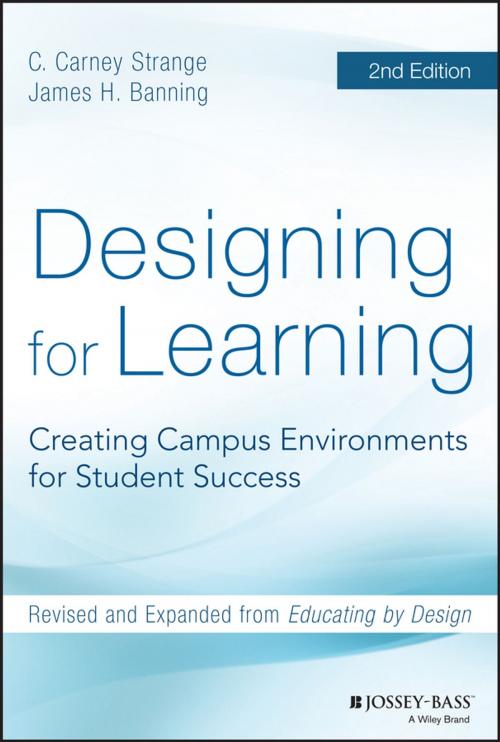Designing for Learning
Creating Campus Environments for Student Success
Nonfiction, Reference & Language, Education & Teaching, Student & Student Life| Author: | C. Carney Strange, James H. Banning | ISBN: | 9781118823507 |
| Publisher: | Wiley | Publication: | June 16, 2015 |
| Imprint: | Jossey-Bass | Language: | English |
| Author: | C. Carney Strange, James H. Banning |
| ISBN: | 9781118823507 |
| Publisher: | Wiley |
| Publication: | June 16, 2015 |
| Imprint: | Jossey-Bass |
| Language: | English |
Understand the design factors of campus environmental theory that impact student success and create a campus of consequence
Designing for Learning is a comprehensive introduction to campus environmental theory and practice, summarizing the influence of collegiate environments on learning and providing practical strategies for facilitating student success through intentional design. This second edition offers new coverage of universal design, learning communities, multicultural environments, online environments, social networking, and safety, and challenges educators to evaluate the potential for change on their own campuses. You'll learn which factors make a living-learning community effective, and how to implement these factors in the renovation of campus facilities. An updated selection of vignettes, case scenarios, and institutional examples help you apply theory to practice, and end-of-chapter reflection questions allow you to test your understanding and probe deeper into the material and how it applies to your environment.
Campus design is no longer just about grassy quads and ivy-covered walls—the past decade has seen a surge in new designs that facilitate learning and nurture student development. This book introduces you to the many design factors that impact student success, and helps you develop a solid strategy for implementing the changes that can make the biggest difference to your campus.
- Learn how environments shape and influence student behavior
- Evaluate your campus and consider the potential for change
- Make your spaces more welcoming, inclusive, and functional
- Organize the design process from research to policy implementation
Colleges and universities are institutions of purpose and place, and the physical design of the facilities must be undertaken with attention to the ways in which the space's dimensions and features impact the behavior and outlook of everyone from students to faculty to staff. Designing for Learning gives you a greater understanding of modern campus design, and the practical application that brings theory to life.
Understand the design factors of campus environmental theory that impact student success and create a campus of consequence
Designing for Learning is a comprehensive introduction to campus environmental theory and practice, summarizing the influence of collegiate environments on learning and providing practical strategies for facilitating student success through intentional design. This second edition offers new coverage of universal design, learning communities, multicultural environments, online environments, social networking, and safety, and challenges educators to evaluate the potential for change on their own campuses. You'll learn which factors make a living-learning community effective, and how to implement these factors in the renovation of campus facilities. An updated selection of vignettes, case scenarios, and institutional examples help you apply theory to practice, and end-of-chapter reflection questions allow you to test your understanding and probe deeper into the material and how it applies to your environment.
Campus design is no longer just about grassy quads and ivy-covered walls—the past decade has seen a surge in new designs that facilitate learning and nurture student development. This book introduces you to the many design factors that impact student success, and helps you develop a solid strategy for implementing the changes that can make the biggest difference to your campus.
- Learn how environments shape and influence student behavior
- Evaluate your campus and consider the potential for change
- Make your spaces more welcoming, inclusive, and functional
- Organize the design process from research to policy implementation
Colleges and universities are institutions of purpose and place, and the physical design of the facilities must be undertaken with attention to the ways in which the space's dimensions and features impact the behavior and outlook of everyone from students to faculty to staff. Designing for Learning gives you a greater understanding of modern campus design, and the practical application that brings theory to life.















